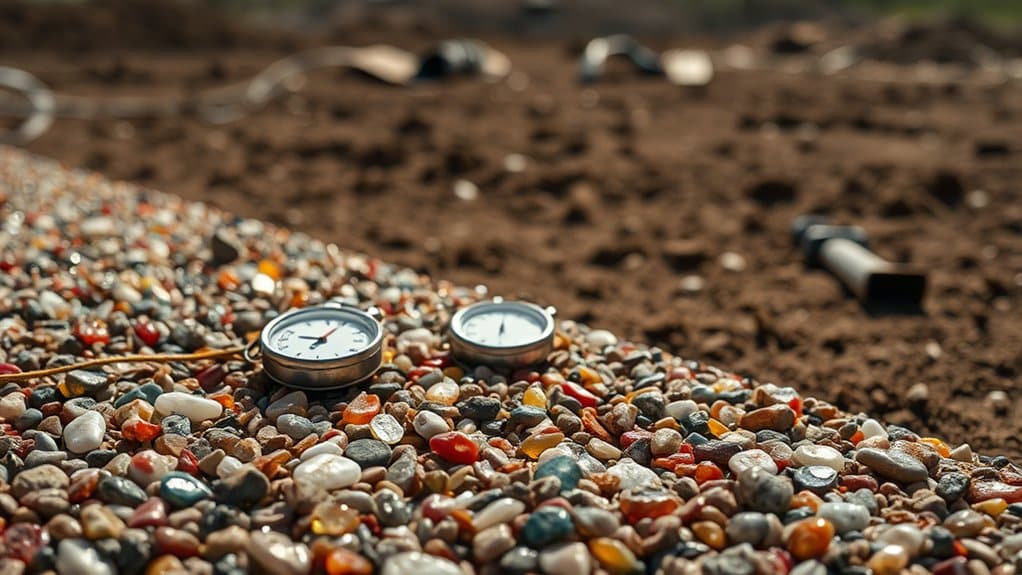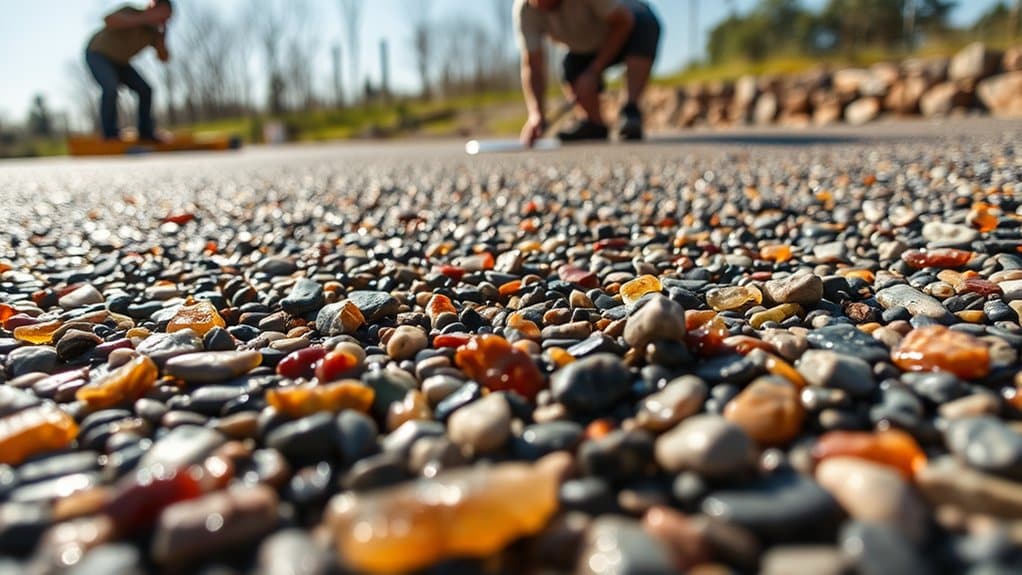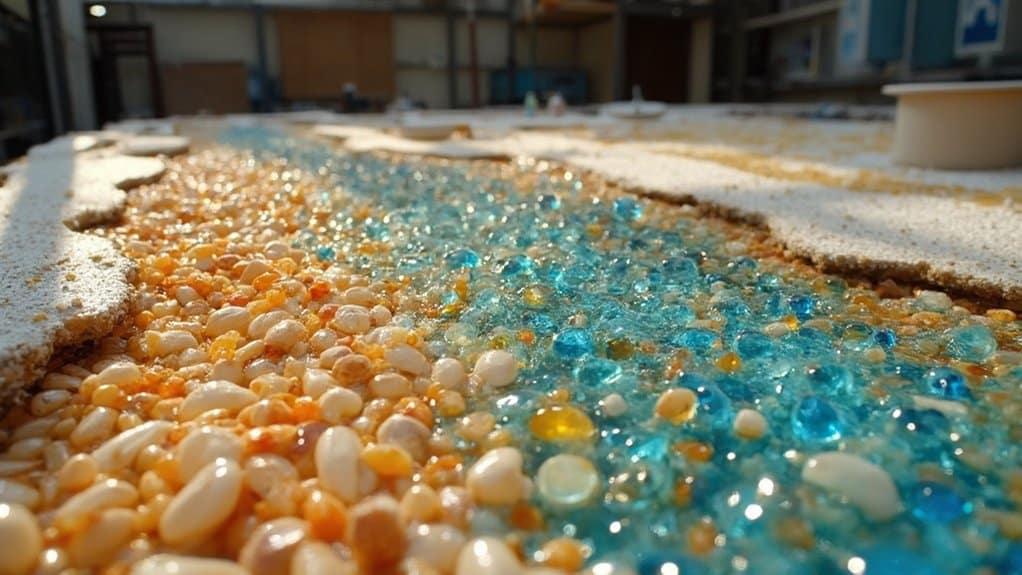Resin-bound gravel sets within 24 hours in ideal conditions, much like concrete. Before laying, ensure you've got a solid, clean base – think of it as preparing a cake tin before baking. Mix your resin and aggregates thoroughly, then pour and spread to achieve a 15-18mm depth (roughly the thickness of your thumb). Weather affects setting time: warmer, drier days speed up the process, whilst damp or cold conditions slow it down. A properly installed surface withstands British weather brilliantly, but avoid heavy foot traffic for the first day to ensure the best results.
Key Takeaways
Setting Times for Resin-Bound Gravel: The Essential Facts
Resin-bound gravel takes 24-48 hours to properly set – roughly the same time you'd wait for paint to dry in your living room. The British weather plays a crucial role in this process.
On a typical UK summer day, expect:
- Initial set: 4-6 hours (walk-on time)
- Full cure: 24 hours
- Vehicle-ready: 48 hours
Wet or humid conditions, which we're rather familiar with in Britain, can extend these times significantly. Think of it like waiting for washing to dry on a damp day – it simply takes longer.
Temperature matters:
- Ideal ground temperature: 5-30°C
- Best air temperature: 10-25°C
Different resin types behave differently. Premium brands often set quicker than budget options, much like how quality paint outperforms cheaper alternatives.
A well-prepared surface is non-negotiable. Just as you wouldn't wallpaper over bumpy plaster, your resin surface needs proper groundwork for the best results.
Base Preparation and Requirements

Base prep for resin-bound gravel requires a stable, clean surface suitable for your project.
Check the base thoroughly for cracks, holes and debris that might affect stability. Power-wash your surface—be it concrete, tarmac or compacted Type 3 aggregate—to remove dirt and grime. The base must meet proper drainage standards, much like a garden patio needs good water run-off. For wobbly surfaces, add stabilising mesh for extra support. Additionally, ensure all materials are on hand before starting the installation, as the quality of materials impacts the final outcome of the resin bound gravel surface. The permeable nature of resin allows for effective rainwater drainage, which is essential for a durable installation. Work when ground temperature is above 10°C for best results. Getting the groundwork right is as crucial as laying a proper foundation for a house—skip it, and you'll face problems later.
Mixing the Resin and Aggregates

Mixing Resin and Aggregates
Getting the mix right is vital for a lasting resin-bound gravel surface. Follow these key steps:
- Equipment: A forced action mixer (such as a SoRoTo) is essential for proper blending.
- Aggregates: Use clean, dry stones in mixed sizes (typically 1-3mm and 2-5mm) for optimal strength. The proper mixing ratios are essential for ensuring durability and longevity in the surface.
- Resin Prep: Mix Parts A and B separately first to ensure proper consistency.
- Adding Materials: Pour aggregates in bit by bit – like adding flour when baking – to prevent clumping.
- Timing: Mix for 3-5 minutes until you achieve a glossy, even coating. Proper mixing time is crucial for achieving the desired durable and long-lasting surface.
Stick to these basics for a reliable, professional-quality mixture every time.
Laying the Resin-Bound Gravel

Pour the resin and aggregate mixture onto your prepared base, spreading it evenly. Use a trowel or screed to distribute the material – you'll need to work quickly as the resin sets in about 20 minutes. Aim for a thickness of 15-18mm, similar to the height of a pound coin. Proper compaction is crucial; think of it like tamping down soil in a garden bed. Press firmly to remove air pockets and create a solid surface that'll last for years. Check the surface is level as you go along, much like spreading butter on toast. As you spread the mixture, ensure that the installation follows the proper gradient to avoid structural issues down the line. Once complete, give it a regular sweep whilst curing to keep it tidy. Getting this stage right means you'll have a smart, durable surface that'll serve you well through British weather, making it ideal for outdoor areas.
Curing Process and Influencing Factors

Getting the best results from resin-bound gravel means understanding how it cures. Several key factors affect the curing time:
- Weather: Typical British summer days (warm and dry) speed up curing, whilst wet weather slows it down.
- Humidity: Much like drying washing outdoors, higher moisture in the air extends curing time.
- Temperature: Both air and ground temperature matter – think how concrete sets differently in summer versus winter.
- Resin Type: Different resins cure at varying speeds, rather like how different paints dry.
- Surface Prep: Just as with painting, a properly prepared surface ensures better results.
Understanding these elements helps ensure your resin-bound surface sets properly and lasts longer.
A well-cured installation also means less environmental impact, as it won't need redoing prematurely.
Post-Curing Maintenance and Care

Regular maintenance keeps your resin-bound gravel looking its best and extends its life.
Sweep weekly with a stiff-bristled broom to remove leaves and prevent moss build-up. When deep cleaning, use a pressure washer on the fan setting—never use metal brushes or harsh tools.
Standard household cleaners work fine for routine washing, whilst specialist treatments are best for stubborn moss and algae. Tackle any spills straight away using mild soap, warm water or bicarbonate of soda.
Keep an eye on shaded spots where moss tends to grow, and sort problems quickly. These simple care steps will keep your surface looking fresh and protect your investment.
Frequently Asked Questions
Can Resin-Bound Gravel Be Installed in Cold Weather?
Installing resin-bound gravel during cold weather is possible but tricky. The cold impacts curing times and can affect the final strength of your driveway or path. Like most outdoor DIY projects in Britain, you'll want to pick your weather window carefully – think of it like waiting for the right moment to paint your garden fence.
For best results, stick to temperatures above 5°C, and ensure the ground isn't frozen or waterlogged. Whilst you might be tempted to crack on with the job during winter, it's worth waiting for milder conditions or getting a professional in to handle the installation properly.
What Colors Are Available for Resin-Bound Gravel?
Natural stone colours for resin-bound gravel range from classic beige and grey to vibrant reds, with over 40 shades available. Common choices include Yorkshire Buff for traditional properties, Silver Grey for modern homes, and Autumn Gold for warm garden paths. The variety allows homeowners to match their driveways and patios to existing brickwork or garden features.
How Long Does Installation Take From Start to Finish?
Installation typically takes 2-4 days for an average driveway or patio. This includes the initial groundwork, laying the base and allowing the resin to properly cure. Larger areas or complex projects might stretch to a week, whilst smaller paths could be completed in a day. Weather conditions can affect timing – we only install in dry conditions for best results.
Is Resin-Bound Gravel Suitable for Driveways?
Resin-bound gravel driveways are a sound long-term investment, typically lasting 25 years with proper care. These surfaces offer a practical blend of durability and kerb appeal, requiring minimal upkeep beyond occasional power washing to maintain their smart appearance. Popular amongst UK homeowners, they're particularly well-suited to our varied weather conditions.
Can I Install Resin-Bound Gravel Myself?
Whilst it's possible to lay resin-bound gravel yourself, it's a complex job that requires proper tools, including a forced action mixer and professional trowels. Success depends heavily on careful preparation and precise mixing ratios. Getting it wrong can be costly, so unless you're particularly skilled at DIY, this task might be better left to specialists.
Conclusion
The curing time of 24 to 48 hours for resin-bound gravel delivers lasting results worth waiting for. Whilst some homeowners might fret about the brief downtime, the finished surface requires minimal upkeep and stands up brilliantly to British weather. Think of it like waiting for paint to dry – a bit of patience leads to proper results. Once set, your new driveway or garden path will serve you well for years, making those two days of waiting seem rather insignificant.
